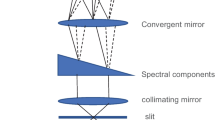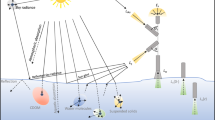Abstract
Spectral reflectance from water surfaces was measured in small (0.01–5 km2), turbid, eutrophic fishponds and mesotrophic quarry lakes in the Třeboň basin (South Bohemia, Czech Republic). A spectral scanner for direct field measurements from water surfaces and a hyperspectral airborne scanner were both used. The quarry lakes and fishponds differed in their spectral signature, which reflected the extent of their eutrophication. Their chlorophyll-a (chl-a) concentrations ranged from 2 to 455 µg/l−1. Various algorithms were tested to best fit the relationships between reflectance patterns and the water-quality parameters used—concentration of chl-a and the total amount of suspended solids. The reflectance ratios at 714 and 650 nm gave the best estimates for chl-a concentrations, and simple reflectance at near infrared wavelengths, especially at 806 nm, gave the best predictive values for total suspended solid evaluation (r 2 = 0.89). Field surface reflectance and airborne sensing measurements were well correlated; however, airborne reflectance data showed higher variability (r 2 = 0.93 and 0.86, respectively). The results support the validity of reflectance measurements, both field and airborne, as a rapid tool for evaluating water quality in many turbid and greatly disturbed, small water bodies.






Similar content being viewed by others
Notes
Diffuse PTFE material, reflects light with ca 98 % (http://www.avantes.com/Colorimetry/White-Reference-Tile/Detailed-product-flyer.html).
References
Abd-Elrahman A, Croxton M, Pande-Chettri R et al (2011) In situ estimation of water quality parameters in freshwater aquaculture ponds using hyperspectral imaging system. ISPRS J Photogramm Remote Sens 66:463–472. doi:10.1016/j.isprsjprs.2011.02.005
Arenz RF, Lewis WM, Saunders JF (1996) Determination of chlorophyll and dissolved organic carbon from reflectance data for Colorado reservoirs. Int J Remote Sens 17:1547–1565. doi:10.1080/01431169608948723
Arst H (2003) Optical properties and remote sensing of multicomponental water bodies. Springer-Praxis book in marine science and coastal management. Springer, Berlin
Bhatti AM, Rundquist D, Schalles J et al (2009) A comparison between above-water surface and subsurface spectral reflectances collected over inland waters. Geocarto Int 24:133–141. doi:10.1080/10106040802460707
Brook A, Ben Dor E (2011) Supervised vicarious calibration (SVC) of hyperspectral remote-sensing data. Remote Sens Environ 115:1543–1555. doi:10.1016/j.rse.2011.02.013
Chipman JW, Olmanson LG, Gitelson AA (2009) Remote sensing methods for lake management: a guide for resource managers and decision-makers. Developed by the North American Lake Management Society in collaboration with Dartmouth College, University of Minnesota, and University of Nebraska for the United States environmental protection agency
Dekker AG (1993) Detection of optical water quality parameters for eutrophic waters by high resolution remote sensing. Ph.D Thesis, Vrije universiteit. Amsterdam
Doxaran D, Cherukuru RCN, Lavender SJ (2005) Use of reflectance band ratios to estimate suspended and dissolved matter concentrations in estuarine waters. Int J Remote Sens 26:1763–1769. doi:10.1080/01431160512331314092
Geomatica Algorithm Reference (2003) PCI Geomatics. 50 West Wilmot Street Richmond Hill, Ontario
Gitelson A (1992) The peak near 700 nm on radiance spectra of algae and water: relationships of its magnitude and position with chlorophyll concentration. Int J Remote Sens 13:3367–3373. doi:10.1080/01431169208904125
Gitelson A, Yacobi Y (2004) Monitoring quality of productive aquatic ecosystem: requirements for satellite sensors. BALWOIS 2004, Ohrid, FY Republic of Macedonia
Gitelson A, Szilagyi F, Mittenzwey K-H (1993) Improving quantitative remote sensing for monitoring of inland water quality. Water Res 27(7):1185–1194
Gordon HR, Morel A (1983) Remote assessment of ocean color for interpretation of satellite visible imagery: a review. Springer-Verlag, New York
Gurlin D, Gitelson AA, Moses WJ (2011) Remote estimation of chl-a concentration in turbid productive waters—return to a simple two-band NIR-red model? Remote Sens Environ 115:3479–3490. doi:10.1016/j.rse.2011.08.011
Hanuš J, Malenovský Z, Homolová L, Kaplan V, Lukeš P, Cudlín P (2008) Potentials of the VNIR Airborne Hyperspectral System AISA Eagle. GIS Ostrav 2008:27–30
Igamberdiev RM, Grenzdoerffer G, Bill R et al (2011) Determination of chlorophyll content of small water bodies (kettle holes) using hyperspectral airborne data. Int J Appl Earth Obs Geoinf 13:912–921. doi:10.1016/j.jag.2011.04.001
Jeník J, Květ J, Papáčková L (2002) Freshwater wetlands and their sustainable future: a case study of the Třeboň Basin Biosphere Reserve, Czech Republic. UNESCO, Paris
Kallio K, Kutser T, Hannonen T, Koponen S, Pulliainen J, Vepsäläinen J, Pyhälahti T (2001) Retrieval of water quality from airborne imaging spectrometry of various lake types in different seasons. Sci Total Environ 268:59–77
Kroupa M, Drbal K (1990) Chemistry of waters in flooded sand pits and its development. In: Krupauer V, Bican J, Drbal K (eds) Extracted ecosystem of Třeboň Biosphere Reserve. Academia Praha, Praha-Staré Město, pp 49–62
Le CF, Li YM, Zha Y et al (2011) Remote estimation of chlorophyll a in optically complex waters based on optical classification. Remote Sens Environ 115:725–737. doi:10.1016/j.rse.2010.10.014
Liu Y, Islam MA, Gao J (2003) Quantification of shallow water quality parameters by means of remote sensing. Prog Phys Geogr 27:24–43. doi:10.1191/0309133303pp357ra
Menken KD, Brezonik PL, Bauer ME (2006) Influence of chlorophyll and colored dissolved organic matter (CDOM) on Lake Reflectance Spectra: implications for Measuring Lake Properties by Remote Sensing. Lake Reserv Manag 22:179–190. doi:10.1080/07438140609353895
Mittenzwey K-H, Ullrich S, Gitelson AA, Kondratiev KY (1992) Determination of chlorophyll a of inland waters on the basis of spectral reflectance. Limnol Oceanogr 37:147–149. doi:10.4319/lo.1992.37.1.0147
Morel A, Prieur L (1977) Analysis of variations in ocean color. Limnol Oceanogr 22:709–722. doi:10.4319/lo.1977.22.4.0709
Moses WJ, Gitelson AA, Berdnikov S et al (2012) Operational MERIS-based NIR-red algorithms for estimating chlorophyll-a concentrations in coastal waters—the Azov Sea case study. Remote Sens Environ 121:118–124. doi:10.1016/j.rse.2012.01.024
Nechad B, Ruddick KG, Park Y (2010) Calibration and validation of a generic multisensor algorithm for mapping of total suspended matter in turbid waters. Remote Sens Environ 114:854–866. doi:10.1016/j.rse.2009.11.022
Olmanson LG, Brezonik PL, Bauer ME (2011) Evaluation of medium to low resolution satellite imagery for regional lake water quality assessments. Water Resour Res 47:W09515. doi:10.1029/2011WR011005
Ouillon S, Douillet P, Petrenko A et al (2008) Optical algorithms at satellite wavelengths for total suspended matter in tropical coastal waters. Sensors 8:4165–4185. doi:10.3390/s8074165
Pechar L (1987) Use of an acetone: methanol mixture for the extraction and spectrophotometric determination of chlorophyll-a in phytoplankton. Algol Stud Archiv für Hydrobiol Suppl Vol 46:99–117
Pechar L, Přikryl I, Faina R (2002) Hydrobiological evaluation of Třeboň fishponds since the end of 19th century. In: Květ J, Jeník J, Soukupová L (eds.) Freshwater wetlands and their sustainable future: a case study of the třeboň basin biosphere reserve, Czech Republic. Man and the Biosphere Series 28, UNESCO & The Parthenon Paris, pp 31–62
Randolph K, Wilson J, Tedesco L et al (2008) Hyperspectral remote sensing of cyanobacteria in turbid productive water using optically active pigments, chlorophyll a and phycocyanin. Remote Sens Environ 112:4009–4019. doi:10.1016/j.rse.2008.06.002
Richter R (2007) Atmospheric/topographic correction for airborne imagery, ATCOR-4 user guide, version 4.2, deutsches zentrum fuer luft- und raumfahrt e. v. (dlr) and rese applications schläpfer, p 125
Rundquist DC, Schalles JF, Peake JS (1995) The response of volume reflectance to manipulated algal concentrations above bright and dark bottoms at various depths in an experimental pool. Geocarto Int 10:5–14. doi:10.1080/10106049509354508
Schaepman-Strub G, Schaepman ME, Painter TH et al (2006) Reflectance quantities in optical remote sensing definitions and case studies. Remote Sens Environ 103:27–42. doi:10.1016/j.rse.2006.03.002
Schalles JF, Rundquist DC, Schiebe FR (2001) The influence of suspended clays on phytoplankton reflectance signatures and the remote estimation of chlorophyll. Verh Int Ver Limnol 27:3619–3625
Schläpfer D, Odermatt D (2006) MODO -modtran4 for remote sensing applications. ReSe Applications Schläpfer, Wil, p 78
Shi K, Li Y, Li L et al (2013) Remote chlorophyll-a estimates for inland waters based on a cluster-based classification. Sci Total Environ 444:1–15. doi:10.1016/j.scitotenv.2012.11.058
Sokoletsky LG, Lunetta RS, Wetz MS, Paerl HW (2011) MERIS retrieval of water quality components in the turbid albemarle-pamlico sound estuary, USA. Remote Sens 3:684–707. doi:10.3390/rs3040684
Sterckx S, Knaeps E, Bollen M et al (2007) Retrieval of suspended sediment from advanced hyperspectral sensor data in the Scheldt estuary at different stages in the tidal cycle. Mar Geod 30:97–108. doi:10.1080/01490410701296341
Sudduth KA, Jang G-S, Lerch RN, Sadler EJ (2005) Estimating water quality with airborne and ground-based hyperspectral sensing. ASAE Paper No. 052006. St. Joseph, Mich.: ASAE
WFD 2000/60/EC: Directive 2000/60/EC of the European parliament and of the council establishing a framework for the community action in the field of water policy
Yacobi YZ, Moses WJ, Kaganovsky S et al (2011) NIR-red reflectance-based algorithms for chlorophyll-a estimation in mesotrophic inland and coastal waters: lake Kinneret case study. Water Res 45:2428–2436. doi:10.1016/j.watres.2011.02.002
Zimba PV, Gitelson A (2006) Remote estimation of chlorophyll concentration in hyper-eutrophic aquatic systems: model tuning and accuracy optimization. Aquaculture 256:272–286. doi:10.1016/j.aquaculture.2006.02.038
Acknowledgments
This work has been supported by grants from the Ministry of Education, Youth and Sports of the Czech Republic Nos. 6007665806 and 2B06068 (2006–2011) and from the Ministry of the Environment of the Czech Republic no. SP/2d3/209/07. It was also supported by grants to Project No. 107/2010/Z of the Grant Agency of the University of South Bohemia, and by the National Infrastructure CzeCOS/ICOS (LM2010007).
Author information
Authors and Affiliations
Corresponding author
Rights and permissions
About this article
Cite this article
Vinciková, H., Hanuš, J. & Pechar, L. Spectral reflectance is a reliable water-quality estimator for small, highly turbid wetlands. Wetlands Ecol Manage 23, 933–946 (2015). https://doi.org/10.1007/s11273-015-9431-5
Received:
Accepted:
Published:
Issue Date:
DOI: https://doi.org/10.1007/s11273-015-9431-5




